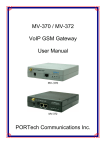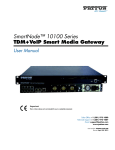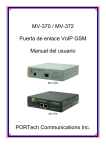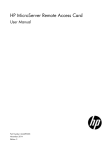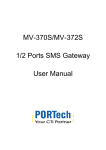Download KW5863 Wireless ADSL Router User Manual
Transcript
KW5863 Wireless ADSL Router User Manual Wireless ADSL Router User Manual NOTICE This document contains proprietary information protected by copyright, and this Manual and all the accompanying hardware, software, and documentation are copyrighted. All rights are reserved. No part of this document may be photocopied or reproduced by mechanical, electronic, or other means in any form. The manufacturer does not warrant that the hardware will work properly in all environments and applications, and makes no warranty or representation, either expressed or implied, with respect to the quality, performance, merchantability, or fitness for a particular purpose of the software or documentation. The manufacturer reserves the right to make changes to the hardware, software, and documentation without obligation to notify any person or organization of the revision or change. All brand and product names are the trademarks of their respective owners. © Copyright 2012 All rights reserved. Wireless ADSL Router User Manual Content 1 OVERVIEW ................................................................................................................................ 1 1.1 FEATURES ................................................................................................................................... 1 1.2 PACKET CONTENTS................................................................................................................... 3 1.3 SYSTEM REQUIREMENTS .......................................................................................................... 4 1.4 FACTORY DEFAULTS ................................................................................................................. 4 1.5 W ARNINGS AND CAUTIONS ....................................................................................................... 4 2 HARDWARE DESCRIPTION ................................................................................................... 5 3 HARDWARE INSTALLATION ................................................................................................. 7 4 PC CONFIGURATION GUIDE ............................................................................................... 8 5 4.1 LOCAL PC CONFIGURATION IN W INDOWS 95, 98, ME, XP ..................................................... 8 4.2 LOCAL PC CONFIGURATION IN W INDOWS 2000 ...................................................................... 9 WEB-BASED MANAGEMENT GUIDE ................................................................................... 9 5.1 LAN SETTING PAGE .................................................................................................................... 9 5.2 INTERNET ACCESS CONFIGURATION............................................ ERROR! BOOKMARK NOT DEFINED. 5.3 W IRELESS SETTING................................................................................................................... 12 5.4 VOIP CONFIGURATION ............................................................................................................. 17 5.5 PRINTER SERVER INSTALLATIONS .......................................................................................... 20 5.6 RESET ROUTER ........................................................................................................................... 22 APPENDIX: FREQUENT ASKED QUESTIONS ..................................................................... 22 Wireless ADSL Router User Manual 1 Overview Thank you for choosing our product. The KW5863H is a Wireless ADSL router combining an ADSL modem, an 802.11n wireless router, a 4-port switch, and two FXS ports in one unit, bringing high-speed wireless Internet connection to a home or office. 1.1 Features 1.1.1 Data rate Downstream data rate up to 24 Mbps Upstream data rate up to 3.5Mbps (With Annex M enabled) 1.1.2 ADSL Compliant ITU G.992.1 (G.DMT) ITU G.992.2 (G.Lite) ITU G.994.1 (G.hs) ITU G.992.3 (G.DMT.BIS) ITU G.992.4 (G.lite.bis) ITU G.992.5 Compatible with all T1.413 issue 2 (full rate DMT over analog POTS), and CO DSLAM equipment 1.1.3 Wireless Fully IEEE 802.11b & IEEE 802.11g & IEEE 802.11n compatible. Wireless data rate up to 300Mbps Operating in the unlicensed 2.4 GHz ISM band Multi-SSID Supports 64/128 bits WEP security and user authentication 1.1.4 Network Protocol & Features Ethernet to ADSL Self-Learning Transparent Bridging Internet Control Message Protocol (ICMP) 1 Wireless ADSL Router User Manual IP Static Routing Routing Information Protocol (RIP, RIPv2) Network Address Translation (NAT) Virtual Server, Port Forwarding Dynamic Host Configuration Protocol (DHCP) DNS Relay, DDNS IGMP Proxy Simple Network Time Protocol (SNTP) VPN pass-through (IPSec/PPTP/L2TP) Parent control 1.1.5 ATM Capabilities RFC 1483 Multi-protocol over ATM “Bridged Ethernet” compliant RFC 2364 PPP over ATM compliant RFC 2516 PPP over Ethernet compliant ATM Forum UNI3.1/4.0 PVC - Up to 16 PVCs VPI Range: 0-255 VCI Range: 32-65535 UNI 3.0 & 3.1 Signaling ATM AAL5 (Adaption Layer type 5) OAM F4/F5 1.1.6 VoIP SIP Voice codecs: G.711A/µ, G.723, G.726, G.729 Call waiting Call forwarding 2 Wireless ADSL Router 1.1.7 1.1.8 1.1.9 1.1.10 1.2 User Manual FIREWALL Built-in NAT MAC Filtering Packet Filtering Stateful Packet Inspection (SPI) Denial of Service Prevention (DoS) DMZ Management Support Web Based GUI Upgrade or update via FTP/HTTP Diagnostic Test Firmware upgrade-able for future feature enhancement Operating System Support WINDOWS 98 WINDOWS 98 SE WINDOWS ME WINDOWS 2000 WINDOWS XP WINDOWS VISTA WINDOWS 7 Macintosh LINUX Environmental Operating humidity: 10%-90% non-condensing Non-operating storage humidity: 5%-95% non-condensing Packet Contents The packet contents are as the following: 3 Wireless ADSL Router 1.3 User Manual ADSL ROUTER x1 External Splitter x1 Power Adapter x1 Telephone Line x1 Ethernet Cable x1 Antenna x2 Base x1 System Requirements Before using this ROUTER, verify that you meet the following requirements: Subscription for ADSL service. Your ADSL service provider should provide you with at least one valid IP address (static assignment or dynamic assignment via dial-up connection). One or more computers, each contains an Ethernet 10/100M Base-T network interface card (NIC). A hub or switch, if you are connecting the device to more than one computer. For system configuration using the supplied web-based program: A web browser such as Internet Explorer v5.0 or later, or Netscape v4.7 or later. 1.4 Factory Defaults The device is configured with the following factory defaults: 1.5 IP Address: 192.168.31.1 Subnet Mask: 255.255.255.0 SSID: VMEDIA Encapsulation: RFC 2516 LLC VPI/VCI: 0/35 Warnings and Cautions Never install telephone wiring during storm. Avoid using a telephone during an electrical storm. There might be a risk of electric shock from lightening. Do not install telephone jacks in wet locations and never use the product near water. 4 Wireless ADSL Router User Manual To prevent dangerous overloading of the power circuit, be careful about the designed maximum power load ratings. Not to follow the rating guideline could result in a dangerous situation. Please note that telephone line on modem must adopt the primary line that directly outputs from junction box. Do not connect Router to extension phone. In addition, if your house developer divides a telephone line to multi sockets inside the wall of house, please only use the telephone that has connected with the splitter of ADSL Router when you access the Internet. Under the above condition, if you also install telephone with anti-cheat-dial device, please pull out this kind of telephone, otherwise ADSL Router may occur frequently off-line. 2 Hardware Description Front Panel 5 Wireless ADSL Router User Manual LED Color PWR Green Function On: Power on Off: No power On: LAN link established and active via LAN port LAN1,2,3,4 Green Blinking: Data activity occurs Off: No LAN link via LAN port On: The wireless module is ready and idle WLAN Green Blinking: Data transmitting or receiving over WLAN Off: The wireless function is off On: ADSL link established and active DSL Green Quick blinking: ADSL is trying to establish a connection Slow blinking: No ADSL link On: IP connected INET Green Blinking: IP traffic is passing thru this device Off: No ADSL connection is present On:A telephone connected to the phone port has its receiver off of the hook . VOIP1,2 Green Off: The handset of telephone connected to the phone port is on-hook. 6 Wireless ADSL Router User Manual Rear panel Port Function DSL Connect the device to an ADSL telephone jack or splitter using a RJ-11 telephone cable FXS1,0 USB Connect the device to your normal phone Connect the device to your printer LAN1,2,3,4 Connect the device to your PC's Ethernet port, or to the uplink port on your hub/switch, using a RJ-45 cable ON/OFF Switch it on or off POWER Connect to the supplied power adapter Side Panel WIFI: The switch of wireless function RESET: System reset or reset to factory defaults WPS: A convenient way to set wireless security 3 Hardware Installation This chapter shows you how to connect Router. Meanwhile, it introduces the appropriate environment for the Router and installation instructions. 1. Using a telephone line to connect the DSL port of ROUTER to the MODEM port of the splitter, and using a other telephone line connect your telephone to the PHONE port of the splitter, then connect the wall phone jack to the LINE port of the splitter. The splitter comes with three connectors as below: 7 Wireless ADSL Router User Manual LINE: Connects to a wall phone jack (RJ-11 jack) MODEM: Connects to the DSL jack of ROUTER PHONE: Connects to a telephone set 2. Using an Ethernet Cable to connect the LAN port of the ROUTER to your LAN or a PC with network card installed. 3. Connect the power cable to the PWR connector on ROUTER, then plug in the power adapter to the AC power outlet, and then press the on-off button. Notes: Without the splitter and certain situation, transient noise from telephone can interfere with the operation of the Router, and the Router may introduce noise to the telephone line. To prevent this from happening, a small external splitter must be connected to each telephone. 4 4.1 PC Configuration Guide Local PC Configuration in Windows 95, 98, ME, XP 1. In the Windows task bar, click the “Start” button, point to “Settings”, and then click “Control Panel”. 2. Double-click the “Network” icon. 3. On the “Configuration” tab, select the TCP/IP network associated with your network card and then click “Properties”. 4. In the “TCP/IP Properties” dialog box, click the “IP Address” tab. Set the IP address as 192.168.31.x (x can be a decimal number from 2 to 254.) like 192.168.31.2, and the subnet mask as 255.255.255.0. 5. On the “Gateway” tab, set a new gateway as 192.168.1.1, and then click “Add”. 8 Wireless ADSL Router 6. User Manual Configure the “DNS” tab if necessary. For information on the IP address of the DNS server, please consult with your ISP. 4.2 7. Click “OK” twice to confirm and save your changes. 8. You will be prompted to restart Windows. Click “Yes”. Local PC Configuration in Windows 2000 1. In the Windows task bar, click the “Start” button, point to “Settings”, and then click “Control Panel”. 2. Double-click the “Network and Dial-up Connections” icon. 3. In the “Network and Dial-up Connections” window, right-click the “Local Area Connection” icon, and then select “Properties”. 4. Highlight “Internet Protocol (TCP/IP)”, and then click “Properties”. 5. In the “Internet Protocol (TCP/IP) Properties” dialog box, set the IP address as 192.168.31.x (x can be a decimal number from 2 to 254.), and the subnet mask as 255.255.255.0 and the default gateway as 192.168.31.1. Then click “OK”. 6. Configure the “DNS” tab if necessary. For information on the IP address of the DNS server, please consult with your ISP. 7. 5 Click “OK” twice to confirm and save your changes. Web-based Management Guide In order to use the web-based management software it will be necessary to use a computer that occupies the same subnet as the Router. The simplest way to do this for many users will be to use DHCP server that is enabled by default on the Router. 5.1 LAN setting page Launch a web browser, such as Internet Explorer, and then use http://192.168.31.1 to log on to the setting pages. 9 Wireless ADSL Router User Manual Enter username ‘admin’ and password ‘admin’ Click OK 5.2 LAN Settings From LAN, Configure the DSL Router’s IP Address and Subnet Mask for LAN interface. In this page, you can use DHCP (Dynamic Host Configuration Protocol) to control the assignment of IP addresses on your local network (LAN only). 10 Wireless ADSL Router Item IP address Subnet mask User Manual Description This is the IP address that other devices on your local network will use to connect to the modem. This defines the size of your network. The default is 255.255.255.0. The DHCP server assigns an IP addresses from a pre-set pool of Disable / Enable addresses upon request from DHCP client (e.g. your computer). DHCP server Do not disable the DHCP server unless you wish to let another device handle IP address issuance on the local network. 11 Wireless ADSL Router User Manual Start / end IP This is the beginning and ending range for the DHCP server address addresses. Lease time The amount of time before the IP address is refreshed by the DHCP server. Configure the second IP Use a second IP address to configure the ADSL router address and... Note: If you want to cancel all modification that you do on the Router, please select from “ManagementSettingRestore Default Settings” to restore factory default settings. 5.3 Wireless setting 5.3.1 Basic 12 Wireless ADSL Router User Manual Option Description Enable A checkbox that enables or disables the wireless LAN interfaces. The default wireless is to enable wireless communications. Enter a name for user’s wireless network here. SSID stands for Service Set Identifier. This name must be between 1 and 32 characters long. The default Network name is VMEDIA. name (SSID) All wireless clients must either detect the gateway or be configured with the correct SSID to access the Internet. BSSID Displays the gateway's wireless MAC address. (User may need this address if user’s using WDS or multiple gateways.) Click Apply to save changes. Country 5.3.2 Drop-down menu that allows selection of specific channel. Security This page allows you to configure security features of the wireless LAN interface. You may setup configuration manually or through WiFi Protected Setup (WPS) 1. Click Security of Wireless item and you’ll see the following page. 2.Configure WPA Pre-shared key as below and click Apply/Save. 13 Wireless ADSL Router User Manual 3.Enable WPS as below. 4.Set WPS AP mode as Unconfigured and click Config AP. 14 Wireless ADSL Router User Manual 5. Set WPS AP mode as configured and click Save/Apply. 6.Now you can use a wireless adaptor with WPS function and the WPS button to connect to access the Internet. 7. To configure security features for the Wireless interface, please open Security item from Wireless menu. This web page offers nine authentication protocols for user to secure user’s data while connecting to networks. There are four selections including Open, Shared, 802.1X,WPA, WPA-PSK, WPA2, WPA2-PSK, Mixed WPA-WPA2, Mixed WPA-WPA2-PSK. Different item leads different web page settings. Please read the following information carefully. The wireless security page allows user to configure the security features of user’s wireless network. There are several security methods to choose from, depending on user’s needs and the capabilities of user’s wireless machines. 15 Wireless ADSL Router User Manual WEP open and WEP shared —WEP is an encryption scheme that is used to protect user’s wireless data communications. WEP uses a combination of 64-bit keys or 128-bit keys to provide access control to user’s network and encryption security for every data transmission. To decode a data transmission, each wireless client on the network must use an identical 64-bit or 128-bit key. WEP is an older wireless encryption method that is not as hard to break as the more-recent WPA. 802.1x — In 802.1x (also known as RADIUS), a separate machine called an authentication server receives a user ID and password. It grants or denies access based on whether the ID and password match any entries in its account list. User can optionally enable WEP encryption with this option. Because it requires a separate machine acting as the authentication server, 802.1x is most often used in business environments. WPA — WPA is a more recent encryption method that addresses many of the weaknesses in WEP. Any client capable of WPA encryption should use it instead of WEP. WPA (PSK) — This is WPA encryption combined with a pre-shared key (PSK), which is a text string known only to the gateway and authorized wireless clients. The gateway rejects the login if the client's PSK does not match. WPA2 — WPA2 is a more advanced encryption method than WPA. Because it is a more recent standard, some of user’s wireless devices might not be able to use it. WPA2 (PSK) — This option uses WPA2 with a pre-shared key. WPA2 and WPA — This option supports WPA2/WPA encryption for devices capable of one or the other standard. The gateway automatically detects whether a particular device can use WPA2 or WPA. WPA2 AND WPA (PSK) — This has WPA2 or WPA encryption based on client abilities, as well as a pre-shared key. 16 Wireless ADSL Router User Manual After making changes, click Apply to save. 5.4 VoIP Configuration 5.4.1 SIP Basic Setting Please Click Stop SIP client before configure SIP parameter and click Start SIP Client after the setting. 17 Wireless ADSL Router User Manual Interface Name: PVC channel for VoIP service. Locale Selection: Keep the value as default if without any request from your ISP. Preferred codec list: Voice codecs. SIP Proxy: SIP proxy server address or domain name of SIP service. You can make it blank if your ISP hasn’t given you the address. SIP Server Port is the signal port of SIP server. The default value is 5060. SIP Outbound Proxy is SIP Outbound server. The default value is 000.000.000.000. The parameter is useful only when the Outbound service is open. SIP Outbound proxy port is the signal port of outbound proxy port. The default value is 5060. SIP Registrar: The SIP server address provide by your ISP. This address is necessary for VOIP setting. SIP Registrar port: the signal port of SIP server. The default value is 5060. Extension: SIP account username provided by your ISP. The value is necessary for VOIP setting. Display Name: The line number assigned by your ISP Password: SIP account password provided by your ISP. The value is necessary for VOIP setting. Input necessary value and then click Start SIP client. 5.4.2 SIP Advanced Setting Please Click Stop SIP client before configure SIP parameter and click Start SIP Client after setting. 18 Wireless ADSL Router User Manual Call waiting: If a calling party places a call to a called party which is otherwise engaged, and the called party has the call waiting feature enabled, the called party is able to suspend the current telephone call and switch to the new incoming call (Typically, this is done by pushing the flash button), and can then negotiate with the new or the current caller an appropriate time to ring back if the message is important, or to quickly handle a separate incoming call. Call Forwarding Number: a feature that allows an incoming call to a called party, which would be otherwise unavailable, to be redirected to a mobile telephone or other telephone number where the desired called party is situated. Forward the incoming call to the number you typed. Select checkbox to enable the call forwarding function. Enable MWI. MWI means Message-Waiting Indication. Usually an audio or visual signal that a voicemail or other type of message is waiting. Call barring: Telephone service feature that restricts certain types of outgoing calls (such as international calls) and/or incoming calls (such as from undesirable callers) with the use of a code. DND: Select the checkbox to enable DND support. The Do Not Disturb or (DND) function prevents calls from ringing on an extension for which DND is activated. Some Do Not Disturb (DND) attributes include directing the call to a pre-assigned extension (like a secretary or assistant), busy signal, DND signal, or recorded message generated by the telephone switch. 19 Wireless ADSL Router 5.5 User Manual Printer Server Installations 1. Click “Advanced setupPrint Server” and then Check “Enable on-board printer server” and key in “Printer name”, “Make and model” 2. Click on Add a printer from Control Panel of the Windows computer and click “Next”. 3. Select “Network Printer” and click “Next”. 20 Wireless ADSL Router User Manual 4. Select Connect to a printer on the Internet, type “http://192.168.31.1:631/printers/printer” and click “Next”. The printer name “Printer” must be the same name entered in the ADSL router “print server setting” as in step 1. 4. Select driver file directory on CD-ROM or in your hard disk and click “OK”. 21 Wireless ADSL Router 6. 7. User Manual Choose “Yes” or “No” for default printer setting and click “Next”. Click “Finish”. 5.6 Reset Router 1. Switch the ADSL router OFF. 2. On the Rear Panel of the ADSL router you will find a small hole with the word "reset" written below it. It's just big enough for a ball-point tip. Insert a ball-point tip into this little hole (actually it's a reset switch) and keep the ball-point tip in there. 3. Switch the router ON, and hold the ball-point tip in the little hole. You can release the ball-point after about 5 seconds. You have then completed the full-reset. Your ADSL router will now have its factory default settings. IP address will be 192.168.31.1 and the subnet mask will be 255.255.255.0. Appendix: Frequent Asked Questions Q: None of the LEDs are on when you power on the ADSL router? A: Please make sure what you use is the power adaptor attached with the ADSL router package and checks the connection between the AC power and ADSL router. Q: DSL LED does not turn on after connect telephone line? A: Please make sure what you use is the standard telephone line (as attached with the package), make sure the line is connected correctly and check whether there is poor contact at each interface. Wait for 30 seconds to allow the ADSL router establishes connection with you ADSL operator. Q: DSL LED is in the circulation of slow-flashing and fast-flashing after connecting telephone line? 22 Wireless ADSL Router User Manual A: This situation means the ADSL router is in the status of failing to establish connection with Central Office. Please check carefully and confirm whether the ADSL router has been installed correctly. Q: LAN LED does not turn on after connect Ethernet cable? A: Please make sure Ethernet cable is connected hub/PC and ADSL router correctly. Then please make sure the PC/hub have been power on. Please make sure that you use parallel network cable to connect UpLink port of hub, or use parallel network cable to connect PC. If connect normal port of hub (not UpLink port), you must use cross-cable. Please make sure that your network cables meet the networking requirements above. Q: PC cannot access the Router? A: Please make sure that all devices communicating with the device must use the same channel (and use the same SSID). Otherwise your PC will not find the wireless Router. Q: PC cannot access the Internet? A: First check whether PC can ping the interface Ethernet IP address of this product successfully (default value is 192.168.31.1) by using ping application. If ping application fails, please check the connection of Ethernet cable and check whether the states of LEDs are in gear. If the PC uses private IP address that is set manually (non-registered legal IP address), please check: 1. Whether IP address of the PC gateway is legal IP address. Otherwise please use the right gateway, or set the PC to Obtain an IP address automatically. 2. Please confirm the validity of DNS server appointed to the PC with ADSL operator. Otherwise please use the right DNS, or set the PC to Obtain an IP address automatically. 3. Please make sure you have set the NAT rules and convert private IP address to legal IP address. IP address range of the PC that you specify should meet the setting range in NAT rules. 4. Central Office equipment may have problem. 5. The country or the wireless network type you selected is wrong. Q: PC cannot browse Internet web page? A: Please make sure DNS server appointed to the PC is correct. You can use ping application program to test whether the PC can connect to the DNS server of the ADSL operator. Q: Initialization of the PVC connection failed? A: Be sure that cable is connected properly from the DSL port to the wall jack. The DSL LED on the front panel of the ADSL router should be on. Check that your VPI, VCI, type of encapsulation and type of multiplexing setting are the same as what you collected from your service provider, Re-configure ADSL router and reboot it. If you still cannot work it out, you may need to verify these variables with the service provider. 23 Wireless ADSL Router User Manual If the cause is not given above, please contact your local service provider! 24




























